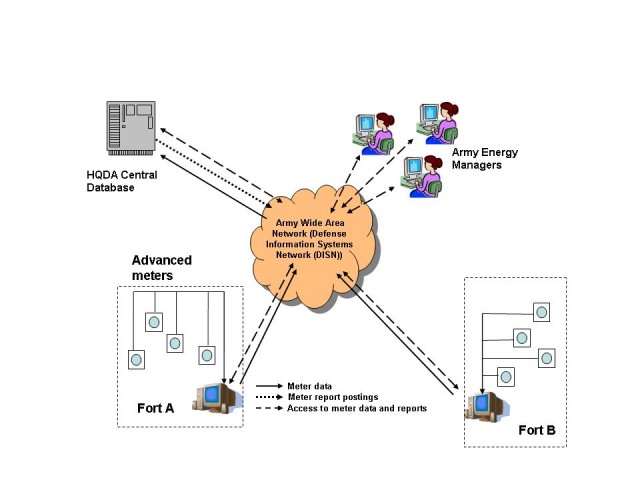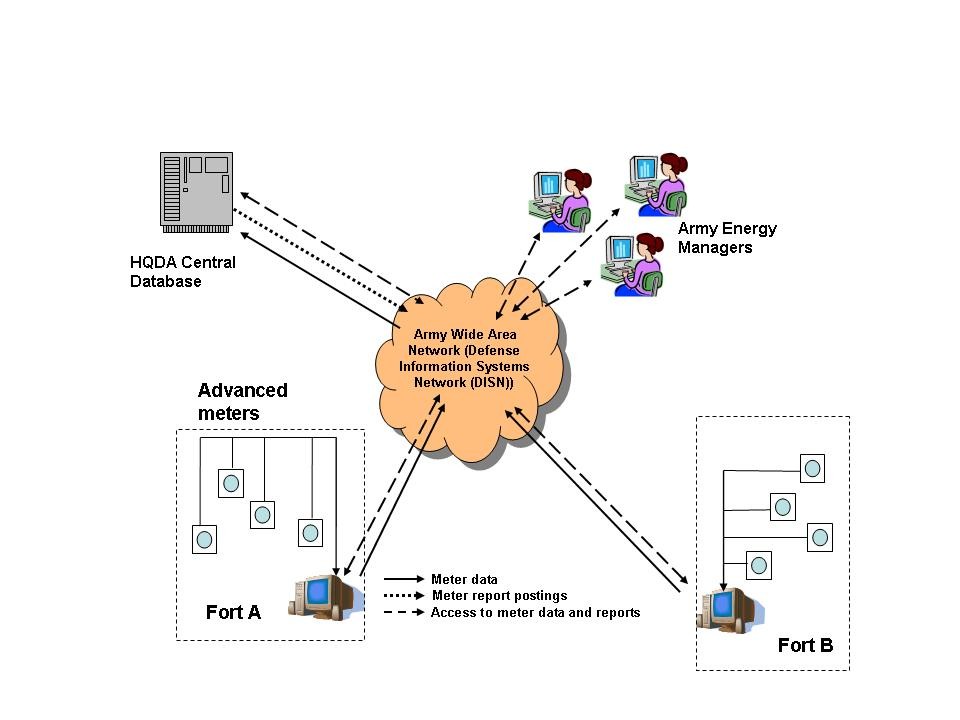Sometimes saving energy is as simple as installing a meter.
In the past, the Army did not have meters on buildings to measure electricity or natural gas use like private homes. Each installation received one big energy bill, not broken down by individual buildings.
That started to change with the Energy Policy Act of 2005 that requires metering in federal buildings by Oct. 1, 2012. Energy-use studies have shown that by metering individual buildings, installations are able to identify which buildings are the biggest energy hogs, and take appropriate measures to reduce energy consumption.
The Army requires the installation of advanced utility meters on military construction projects and for renovation or energy projects of $250,000 or more that include electrical, natural gas, water or steam components.
The Army Metering Program is installing advanced meters with remote reporting capability to a central data base accessible via the Engineering Knowledge Online Web site. This will provide Army installations the capability to measure and track electricity, water, natural gas and steam consumption at the facility level. It is one way the Army is working to meet established goals for energy reduction.
USACE manages metering and energy programs
The U.S. Army Corps of Engineers' Engineering and Support Center in Huntsville, Ala., manages Army metering and other energy programs for the Office of the Assistant Chief of Staff for Installation Management (ACSIM) and the Installation Management Command (IMCOM).
Installation of electric advanced meters began in FY08 on facilities that were deemed cost effective to meter based upon the Office of the Secretary of Defense criteria, which says that buildings that consume an estimated $35,000 per year in electrical costs are economically justified for metering.
For Army planning and budgeting purposes, the $35,000 per year electrical cost equates to buildings of 29,000 square feet or more.
"This translates to approximately 6,700 Army, Army Reserve and Army National Guard facilities to be metered at more than 480 sites worldwide," said Lawson (Stan) Lee, chief of the Facility Support Division at the Huntsville Center. "Electricity, natural gas, water and steam or high-temperature water will all be metered. To determine the exact number of meters required, all installations are currently being surveyed in phases. The anticipated scope is a total of 13,000 advanced meters."
As of July 2009, the Huntsville Center has awarded meter installation contracts for 36 Army installations. Approximately 3,000 electric and natural gas meters have been installed. By the end of fiscal 2009, the Army will have installed advanced electric meters on 47 percent of its facilities that are economically justified for metering, according to David Purcell, Army Energy Program Manager for ACSIM's Facilities and Policy Division. This amounts to 3,151 of 6,700 required by the end of fiscal 2012.
In December 2008, Huntsville Center awarded the contract for a Meter Data Management System (MDMS) to receive meter readings from across the Army.
"Once implemented and certified networthy, Directorate of Public Works energy managers and anyone else with Army Knowledge Online access will be able to select among an extensive menu of number crunching reports using almost real time meter data for any and all metered facilities of interest," Lee said. "Time of use, peak power demand, trending, comparisons of the energy consumption per square foot for similar facilities, correlation of meter readings with local weather data ... the potential analytical applications are huge."
Pilots at Fort Carson, Fort Lee and Fort Stewart
Pilot testing of this system is scheduled at three installations by October: Fort Carson, Colo., Fort Lee, Va., and Fort Stewart, Ga. These will be followed by Army-wide implementation, phased in accordance with the status of meter installation.
"Information from the pilot sites is being compiled so that a roadmap can be developed and implemented to demonstrate the MDMS proof of concept from smart meter readings," said Jefferey Murrell, metering program manager at the Huntsville Center.
"The Army is ahead of schedule for its required advanced electric meter installation," Purcell said. "In fiscal 2008, $19.6 million was spent on advanced meters and $2.8 million was spent on the MDMS. In fiscal 2009 to date, $14.5 million has been spent on meters and $3.2 million on MDMS.
"We expect approximately $20-25 million per year for fiscal years 2010-12 to complete the majority of the electric metering and a large percentage of the natural gas metering, and approximately $5-7 million per year for fiscal years 2010-12 for implementation of the MDMS, followed by $1-2 million per year for operation and maintenance of the MDMS," Purcell said.
The total estimated number of buildings determined to be cost effective to meter for natural gas is 2,200 based on experience, with 33 percent of buildings requiring electric meters also requiring a natural gas meter. To date, 727 advanced natural gas meters have been installed, which equates to 33 percent completion, ahead of schedule for the required gas metering completion date of Sept. 30, 2016.
"When the Army Metering Implementation Plan is completed, advanced electric meters will be metering more than 50 percent of total electrical consumption," Purcell said. "This coverage will increase due to the meters being installed on MILCON and repair/renovation projects."




Social Sharing